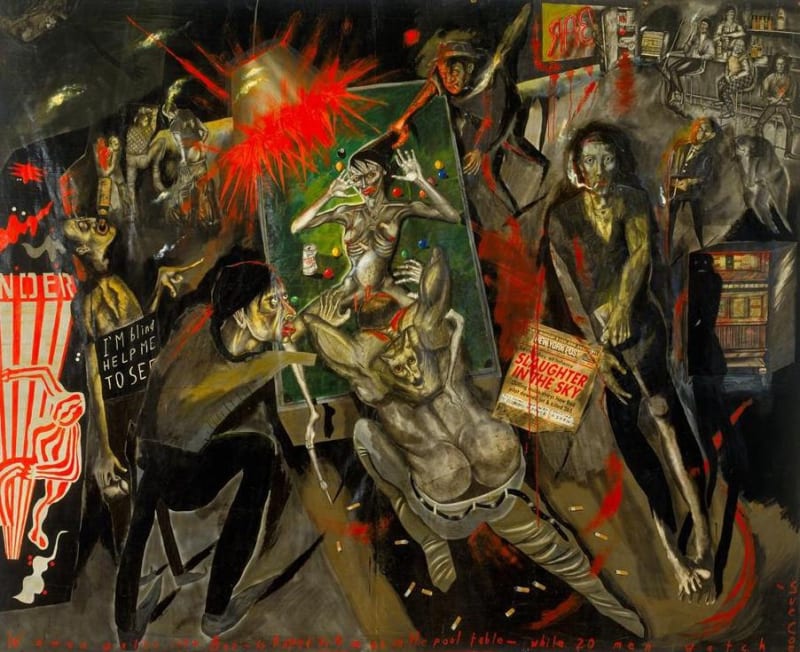Sue Coe takes the gloves off at the Hirshhorn.
"SOCIALISM WAS BETRAYED," Sue Coe says with the matter-of-factness of stating that water boils at 100 degrees Celsius. "It was betrayed by people like Gorbachev." The artist, 42, makes this comment in the small, dark Manhattan apartment she occupies with two pet rats (which have tumors from lab-induced cancer) and a tuxedo cat who, she warns, just might scratch. The dilapidated brown walls are covered with dour social-protest art from the '20s and '30s; on a living-room easel stands (in progress) one of Coe's 100-and-counting excoriations of the meatpacking industry, replete with red splatters. Coe herself is dressed all in black, including a beret reminiscent of Patty Hearst in SLA garb. "There's a poem by this Polish poet," she muses. "When he was a young man, he'd go up in a Ferris wheel with his girlfriend. At the top, he'd see the Warsaw ghetto and the horror of it. But by the time he got to the bottom, he'd forgotten all about it. I'm interested in that mechanism in the human mind that allows for this continuing genocide." Continuing genocide, for Coe, means the AIDS crisis, the gulf war, and killing animals for food and research.
The brochure for her latest exhibition, in fact, unabashedly quotes her on "the economic crime of capitalism." This ferocious, soapboxy show is, mind you, smack in the middle of the Hirshhorn Museum in Washington, D.C. (through June 19). The building was insinuated onto the Mall by the entrepreneurial clout of the late mining mogul Joseph H. Hirshhorn. The dozen works in the exhibition (mixed-media drawings and two large unstretched paintings) scathingly indict everything from the CIA's connection to the South African police to the invasion of Grenada to the Thomas-Hill hearings-right on the turf that hatched them. Notes Coe, "A lot of people ask, 'Why is that so negative?' To me, it's not negative to reveal reality."
Coe speaks her words, however, with a lilting English north-country accent (she was born near Birmingham) that remains with the listener like music. She smiles a lot, sometimes even laughing infectiously. And in the decidedly market-driven art world, Coe is represented by an elegant gallery specializing in master drawings.
At one point, Coe worked in a candy factory, where, she remembers, "we could eat as many Mars bars as we wanted on the factory floor, but we couldn't take them off the premises. Not one Mars bar." For a few years she attended the Royal College of Art, where "we never saw women artists, and had abstraction crammed down our throats." Coe came to New York in 1972. "I left for adventure," she says, and adds, with one of those smiles, "And now I've had too much adventure."
Coe makes a living as an illustrator, with her searing, uncompromising drawings gracing the Village Voice, The New York Times's op-ed pages (when she agrees with the essay), The New Yorker, Time and NEWSWEEK. Coe calls herself a "cultural worker," not an artist, and says of her colleagues slaving over page layouts, typography and spot drawings: "That's the real talent, not this fine-art crap."
The fact is, Coe is an artist, and a very good one. Her dark, sinewy figures suffering the torments not of the heavens but of earth-bring to mind Goya and Daumier. Her blunt pictures clear your moral sinuses like ammonia. The big painting "Woman Walks Into Bar-Is Raped by 4 Men on the Pool Table-While 20 Watch" (1983) depicts exactly that, from an all-inclusive overhead view. And the small drawing "War" (1991) sums up just how-rationale aside-we bombed people over there in Iraq. Coe's mostly monochrome art is worked and reworked into a despairing shine; little bits of subtle color and islands of manic texture crop up throughout it. Propaganda doesn't need such visceral refinements; only art does.
It's not that Coe doesn't like art. "It's just my bad skills if it looks too expressionistic," she demurs, reaching for a book on Rembrandt. Opening it to sketches of a woman being garroted, she says, "This is what I want the work to be like ... not that I could ever get close to Rembrandt." She doesn't get real close (Who ever did?). But she has the eye, the hand and the passion to get a bit closer. Her politics, depending on where you stand, are a bonus or a curse.
